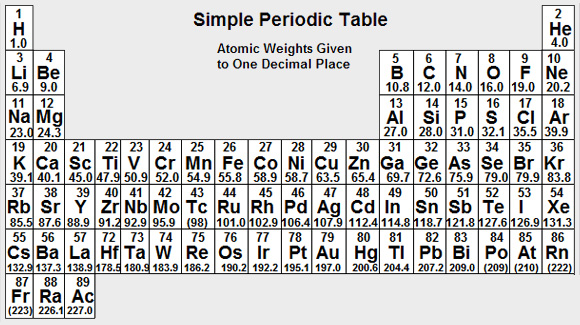For the next question, click on the Next Question button.
Question 1 of 5
What is the concentration expressed as % w/w of a 2.598 M solution of Sucrose (RMM 342 g) if the density of the solution is 1.332 g/ml? Answer to 1 decimal place.
- Find the mass of Sucrose in 1000 ml of solution.
1000 ml of solution contains 2.598 moles of Sucrose. Thus:
Mass of Sucrose = Moles x RMM = 2.598 x 342 g = 888.516 grams -
Find the mass of 1000 ml of solution - use the given density of 1.332 g/ml.
1 ml of solution weighs 1.332 g. Thus:
1000 ml of solution weighs 1332 grams. -
Find the mass of Sucrose in 100 g of solution.
1000 ml of solution contains 888.516 g of Sucrose. From 2 you know that:
1332 g of solution contains 888.516 g of Sucrose. Thus:
100 g of solution contains 100/1332 x 888.516 g = 66.70 g of Sucrose
No, that is not the correct answer.
Have another go: just type in your new answer and press Enter.
If you continue to have problems, have a look at the answer.
For the next question, click on the Next Question button.
Question 2 of 5
What is the molality of a 0.2228 M aqueous solution of Chlorhexidine Gluconate (RMM 897.7) if the solution's density is 1.065 g/ml? Answer to 4 significant figures.
- Find the mass of Chlorhexidine Gluconate (CG) in 1000 ml of solution.
1000 ml of solution contains 0.2228 moles of Chlorhexidine Gluconate. Thus:
Mass of Chlorhexidine Gluconate = Moles x RMM = 0.2228 x 897.7 = 200.007 grams -
Find the mass of 1000 ml of solution - use the given density of 1.065 g/ml
1 ml of solution has a mass of 1.065 g. Thus:
1000 ml of solution has a mass of 1065 grams -
Find the mass of solvent in 1000 ml (1065 grams) of solution.
Mass of solvent = Mass of Solution - Mass of Chlorhexidine Gluconate
Mass of solvent = 1065 - 200.007 g = 864.993 grams -
Find the number of moles associated with 1000 g of solvent.
864.992 g of solvent are associated with 0.2228 moles of CG. Thus:
1000 g of solvent are associated with 1000/864.992 x 0.2228 moles = 0.25757 moles
No, that is not the correct answer.
Have another go: just type in your new answer and press Enter.
If you continue to have problems, have a look at the answer.
For the next question, click on the Next Question button.
Question 3 of 5
What is the mole fraction of Formaldehyde (RMM 30.0) in a 12.96 molar aqueous solution of Formaldehyde if the density of the solution is 1.08 g/ml? (RMM of Water = 18.02). Answer to 4 decimal places.
- Find the mass of Formaldehyde in 1000 ml of solution.
1000 ml of solution contains 12.96 moles of Formaldehyde. Thus:
Mass of Formaldehyde = Moles x RMM = 12.96 x 30.0 g = 388.8 grams -
Find the mass of 1000 ml of solution - use the given density of 1.08 g/ml.
1 ml of solution has a mass of 1.08 g. Thus:
1000 ml of solution has a mass of 1080 grams -
Find the mass of Water present in 1000 ml (1080 g) of solution.
Mass of Water = Mass of Solution - Mass of Formaldehyde
Mass of Water = 1080 - 388.8 g = 691.2 grams -
Find the mole fraction of Formaldehyde.
Moles of Formaldehyde = 12.96 moles
Moles of Water = Mass/RMM = 691.2/18.02 = 38.357
No, that is not the correct answer.
Have another go: just type in your new answer and press Enter.
If you continue to have problems, have a look at the answer.
For the next question, click on the Next Question button.
Question 4 of 5
What is the normality of a 1.650 molar solution of Potassium Sulphate? Answer to 4 significant figures.
- Find the mass of one equivalent of Potassium Sulphate.
Mass of Equivalent = RMM/Valency = 174.3/2 = 87.15 grams -
Find the mass of Potassium Sulphate in 1000 ml of solution.
1000 ml of solution contains 1.650 moles of Potassium Sulphate. Thus:
Mass of Potassium Sulphate = Moles x RMM = 1.650 x 174.3 g = 287.595 grams -
Find the number of equivalents of Potassium Sulphate in 1000 ml of solution.
Number of Equivalents = Mass of Potassium Sulphate / Mass of One Equivalent
Number of Equivalents = 287.595/87.15 Eq = 3.3000 Eq
No, that is not the correct answer.
Have another go: just type in your new answer and press Enter.
If you continue to have problems, have a look at the answer.
Question 5 of 5
What is the concentration expressed as % w/v of a 0.7500 molar solution of Potassium Permanganate (KMnO4)?
Answer to 2 decimal places.
- Find the mass of Potassium Permanganate present in 1000 ml of solution.
1000 ml of solution contains 0.7500 moles of Potassium Permanganate. Thus:
Mass of Potassium Permanganate = Moles x RMM = 0.7500 x 158 g = 118.50 grams -
Find the mass of Potassium Permanganate in 100 ml of solution.
1000 ml of solution contains 118.50 g of Potassium Permanganate. Thus:
100 ml of solution contains 100/1000 x 118.50 g of Potassium Permanganate
100 ml of solution contains 11.850 g of Potassium Permanganate.
ie 11.85 % w/v to 2 dec pl.
No, that is not the correct answer.
Have another go: just type in your new answer and press Enter.
If you continue to have problems, have a look at the answer.
of that component in 1000 cm3 of the total system.
of the number of moles of that component to the total number
of moles of all components within the system.
